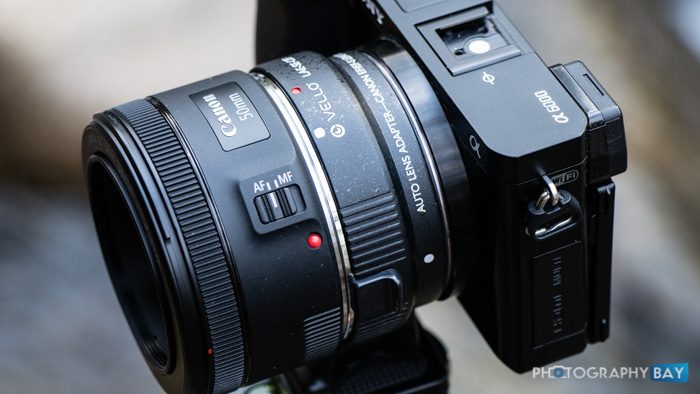The one thing I love about Sony cameras is the flexibility the cameras offer and how open Sony is to third-party lenses and accessories. If you go to any tradeshow, Sony reps will openly talk about how their cameras can use Canon or Nikon lenses (among others) on Sony cameras thanks to third-party lens adapters. A few years ago, these adapters were sometimes hard to find at a good price – but that’s no longer the case with a variety of options on the market today.
Today, we’re looking at the affordable Vello Auto Lens Adapter for Canon EF lenses to Sony E-Mount cameras. It works with full frame and APS-C format cameras and lenses. It passes focus and aperture functions through the adapter for full control of Canon EF and EF-S lenses on Sony cameras.
Unlike the previously-reviewed Metabones Speedbooster, the Vello adapter doesn’t have any optics inside. It is merely a mount adapter with electronics inside. It supports autofocus with USM and STM lens motors and autoexposure across the range of exposure modes on Sony cameras.

My testing is limited to the Sony A6000 with a variety of Canon lenses. The Vello adapter performed as I expected it to perform in most respects. The exposure communication between camera and lens was flawless, while the autofocus performance lagged behind.
On some lenses, the adapter would sometimes completely failed to focus and other times it would focus quickly. The EF-S 18-135mm lens with nano USM AF motor did this most frequently. The adapter did not function with the electronic aperture or focus controls at all when using the older Sigma 70-200mm f/2.8 EX DG HSM lens. This lens is circa 2005. Your mileage may vary with third-party EF lenses. You can also look at the compatibility chart for the adapter on the B&H product page to make sure your lenses function properly.
I suspect the adapter will perform a bit better with the latest A7 models, but for $100 it does a fantastic job of getting Canon glass on my Sony camera.

In everything but the best lighting situations, the A6000 took a several seconds to focus as it pumped the focus motor back and forth looking for the contrast focus point. When it hit, the focus was accurate; however, the time it took to achieve autofocus was unacceptable for anything but static subjects.
When I tested the $650 Metabones Speedbooster, I experienced similar sluggish AF issues on the A6000 and A5100. The Metabones has a bit of a steep price to pay for something with such a performance hit. However, if you aren’t shooting moving objects and you just want autofocus, paying $100 for the Vello adapter makes perfect sense if you can keep using all of your Canon glass on Sony cameras.
Manual focus is easy enough on recent Sony E-mount cameras with focus peaking and assist zoom modes available for getting a sharp image. I have a couple native Sony E-mount lenses; however, most days I’m shooting with Canon lenses on my Sony A6000.
One nitpick is that the included tripod foot on the adapter has a 1/4″-20 hole that is too shallow for some of my tripod plates. That’s not a deal killer but it’s a little frustrating that my standard Manfrotto 200PL plate can’t mount securely on the adapter’s foot.
I’m planning to move completely to Sony from Canon but I’ve got a lot of Canon lenses that I may be using for a while longer as I make the transition. I know there are many other photographers in similar circumstances as they transition from Canon or Nikon over to Sony. Any maybe you’re like me and you ride the fence for a couple years with a lower end Sony model like the A6000 before you make up your mind.

For the price, the Vello Auto Lens Adapter is a solid option for getting your Canon glass on your Sony camera (with the caveat about autofocus I mention above).
You can find the Vello Auto Lens Adapter at Photography Bay’s trusted retail partner, B&H Photo, via the following links:
Vello Auto Lens Adapter for Canon Lens to Sony E-Mount Camera
By making your photography purchases at B&H Photo through these links, you are helping Photography Bay to continue bring quality camera tests, news and reviews. Thanks for your continued support.



Playing Devil’s Advocate….
1) Surely when you fit any adaptor/converter onto a lens, you are increasing the length of the barrel and therefore the ratio between the diameter of the hole at the end of the barrel, and the length of the barrel… Therefore you effectively change the f-stop rating.
2) Mirrorless bodies do NOT have the internal mirror mechanism which makes the body slimmer…. So by using a lens which was designed to be used on a D/SLR body ( Wider gap between the rear of the lens and the sensor) means that the gap between the rearmost glass element of the lens and the sensor is now different, and this now changes to optics….
I understand that adapting D/SLR lenses to mirrorless bodies “works OK” , but it is not optimum, so this is a compromise….
The way to go is to rather use lenses specifically designed for mirrorless bodies…. ie: The SONY G Master range was designed for the SONY……https://www.sony.com/electronics/engineer-interviews-g-master-lenses
While I know that using G Master lenses is the more expensive way to go, I have proved conclusively by my results that the G Master range of lenses are as good as you will get!